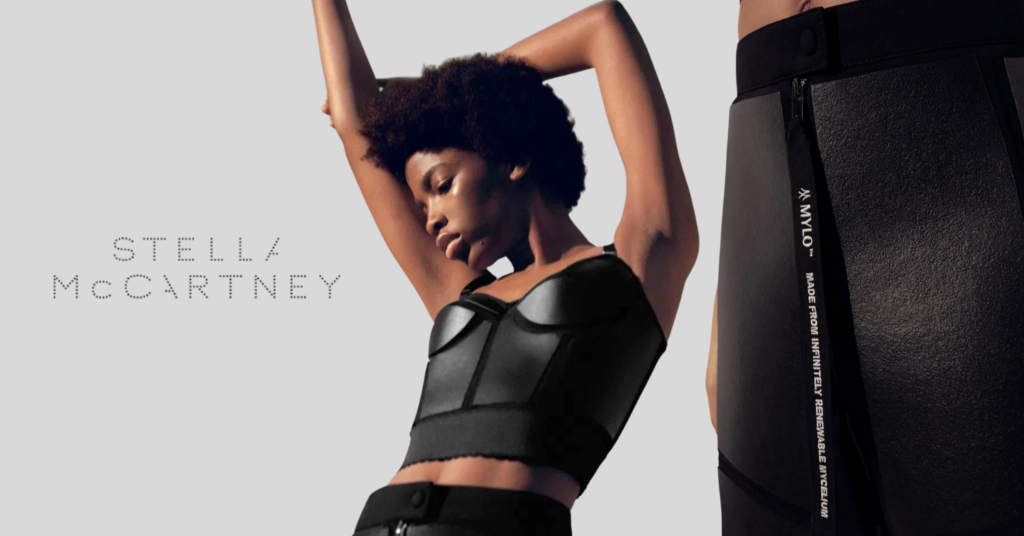Updated March 22, 2021. Stella McCartney just introduced the world’s first-ever garments made entirely with Mylo mushroom leather: a black bustier and a pair of balloon leg utility trousers.
Working with biotechnology company Bolt Threads — also known for its Microsilk — the English fashion designer has helped develop and perfect the texture and appearance of Mylo: a natural, biodegradable, and 100 percent vegan mushroom “un-leather.”
This biofabricated material is actually produced using mycelium, the complex (and infinitely renewable) root structure of mushrooms. While there is increasing competition in the mycelium space, Bolt Threads’ mushroom leather is unique in its look, feel, and drape.
Back in 2018, the London Victoria & Albert Museum displayed Stella McCartney’s Falabella handbag, made using Mylo, as part of its “Fashioned from Nature” exhibit.
Previously it was impossible to create pieces of Mylo that were large and pliable enough to cut into pants. But now, the mushroom leather can be produced and finished in a variety of weights and textures, including pebbled and ultra-soft.
“We’d already done a bag, so I wanted to do the ready-to-wear to give a bit more insight into how much you can do with this material, and how it can be swept across the industry to actually replace leather,” Stella McCartney told Vogue.
“The main thing is there’s really no compromise,” she continued. “I always say that I don’t want anyone to know our products aren’t made of leather, and it’s so important to me that they stand shoulder to shoulder with the real thing.”

‘You can’t argue how this is better’
Many people avoid leather for ethical reasons — for example, the softest high-end leather typically comes from newborn or even unborn calves — but there are many environmental reasons to switch to plant-based and sustainable versions, too.
Rearing cattle, whether primarily for beef or for leather, is one of the leading global contributors to greenhouse gas emissions. It also consumes huge quantities of land and resources. In addition, the tanning process can be incredibly toxic. The majority of leather is chrome tanned, which can result in chromium (VI), a known carcinogen, entering the water supply.
In contrast, mycelium can grow on a sheet of sawdust in approximately two weeks, and its carbon footprint is generally considered to be exceptionally small. Dan Widmaier, Mylo’s founder and CEO, told Vogue: “Our preliminary impact assessment indicates the incredible environmental benefits of mycelium-based leather.”
“As disposable incomes rise around the globe, so will the demand for meat and leather goods. This demand can’t be met using the land and water it takes to raise cattle. We need smarter, more sustainable solutions,” he added.
“It’s just so much better for the planet — whether you’re doing it for ethical reasons or not, you can’t argue how this is better,” said McCartney. “This is the future of fashion.”
From mushroom leather to sustainable construction
Bolt Threads recently announced that Adidas, Kering, and Lululemon, along with Stella McCartney, would have exclusive access to Mylo. This will help develop additional sustainable technologies, and scale its production of mushroom leather.
However, Bolt Threads is not the only company developing a patented process for animal-free leather production. California’s MycoWorks recently produced a high-end bag with French fashion label Hermès, while German-based brand ZVNDER also creates sustainable mushroom leather.
Mycelium, in general, has been used in the production of vegan meat, as a sustainable packaging, and even for environmentally friendly building materials. While currently still experimental, experts predict that mycelium could be a green alternative to a wide variety of finite or otherwise unsustainable raw materials, food, and textiles.
Editor’s note: Since publication, this article has been corrected. While Mylo’s key ingredient mycelium can grow on sawdust in just two weeks, turning it into the vegan leather used by Stella McCartney requires processing and finishing.


